Contents
 Summary
Summary
- Q3 2017 results reported on October 24, 2017 with quarterly net profit down 1% to $0.958B but increased demand evidenced.
- Investment in rail infrastructure is being increased by $0.1B to $2.7B and hiring is expected to increase by ~600 people so as to handle volume growth.
- Reaffirmed adjusted diluted EPS of $4.95 - C$5.10 versus 2016 adjusted diluted EPS of $4.59.
- New normal course issuer bid for the repurchase of up to 31 million common shares (4.9% of issued and outstanding common shares) commencing Oct. 30, 2017 and ending no later than Oct. 29, 2018.
NOTE: All financial results are expressed in Canadian dollars unless otherwise noted.
Introduction
The TSX listed shares of Canadian National Railway (TSX: CNR) (NYSE: CNI) is a component of the FFJ Portfolio. I initially covered CN in this post and I recently covered Canadian Pacific Railway (TSX: CP) (NYSE: CP), the other member of Canada’s railway oligopoly in this post.
On October 24, 2017, CN released its Q3 2017 results. Management indicated it remains on track to see its annual profit grow as demand increases after six quarters of decline. It does, however, have some short term challenges which are being addressed.
Business Overview
CN’s ~23,000 railroaders transport $250B+of goods annually for a wide range of business sectors ranging from resource products to manufactured products to consumer goods. Its ~20,000 route-miles rail network spans Canada and mid-America. It, and its operating railway subsidiaries, serves the cities and ports of Vancouver, Prince Rupert, B.C., Montreal, Halifax, New Orleans, and Mobile, Ala., and the metropolitan areas of Toronto, Edmonton, Winnipeg, Calgary, Chicago, Memphis, Detroit, Duluth, Minn./ Superior, Wis., and Jackson, Miss..
The following images provide a glimpse of CN’s expansive network and track record since 2010.
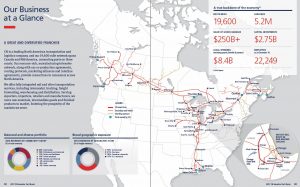
 Source: 2017 Investor Fact Book
Source: 2017 Investor Fact Book
Milton Logistics Hub (MLH)
One of CN’s key regions is the Greater Toronto Hamilton Area (GTHA). It is the most heavily populated and fastest-growing region in Canada; the population of the GTHA is expected to increase from 6.6 million to 10 million by 2041.
CN currently services the GTHA through its Brampton Intermodal Terminal (BIT). It is Canada’s largest terminal and it connects the region with 20 domestic trade terminals and 7 CN-served container ports across North America. BIT, however, is nearing capacity and its ability to meet growing demand for container goods in the region is severely constrained.
In order to alleviate the strain on the BIT, CN announced in April 2015 its intent to build the MLH at an estimated cost of ~$0.25B. The process through which CN must obtain approval is extensive; CN is currently in the Environmental Impact Statement (EIS) portion of the Independent Review Panel Process.
The MLH would be built on 400 acres of land owned by CN. Services would complement those currently offered at BIT. The proposed location is adjacent and parallel to the existing CN tracks on land adjacent to CN’s Halton Subdivision, one of CN’s existing mainline corridors in the western half of the GTHA.
If approved, the MLH would operate 24 hours/day, 7 days/week. It is designed to be served by 4 intermodal trains/day and is expected to handle 450,000 containers annually at full operation. NOTE: One intermodal train can transport the equivalent of 280 long-distance heavy trucks.
Community consultation sessions are currently being held until October 31, 2017. Details on this massive undertaking can be found here.
Q3 and YTD2017 Financial Results
CN reported 3 month and 9 month results on October 24, 2017.

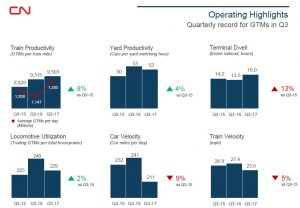 Source: Q3 2017 Analyst Presentation
Source: Q3 2017 Analyst Presentation
While some metrics improved relative to Q3 2015 and 2016, several metrics deteriorated. One of the metrics which deteriorated from Q3 2016 was the Operating Ratio (54.7% versus 53.3% in Q3 2016) which is defined as operating expenses as a percentage of revenue; a lower ratio is more favorable.
A major reason for same is that CN had an insufficient number of crews to handle the increased demand prompted by a stronger North American economy. This shortfall in crews is because fewer laid-off workers than expected chose to return following a lengthy idle period; steps are currently being taken to address this shortfall.
CN reports its earnings in Canadian dollars. A large portion of its revenues and expenses, however, is denominated in U.S. dollars. The fx fluctuation affects the conversion of the Company's U.S.-dollar-denominated revenues and expenses and in Q3; CN’s net income was negatively impacted by $0.022B, or $0.03 per diluted share.
Market Outlook
The following is CN's market outlook for 94% of its business.
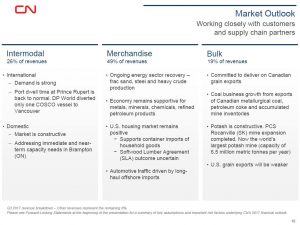 Source: Q3 2017 Analyst Presentation
Source: Q3 2017 Analyst Presentation
Subsequent to CN's Q3 earnings announcement, Canada's central bank announced on October 25, 2017 that it will keep its key lending rate on hold amid concerns that the average Canadian is overly indebted. In addition, souring negotiations around the North American Free Trade Agreement (NAFTA) are clouding the outlook for the Canadian economy; this could negatively impact CN.
Dividend Yield and Valuation
The quarterly / annual dividend is $0.4125 / $1.65. Using the current ~$104.50 stock price (October 25, 2017 close of business), this translates to a dividend yield of 1.58%. This yield is comparable to that in FY2012 and FY2013 but inferior to that in FY2015 and FY2016.
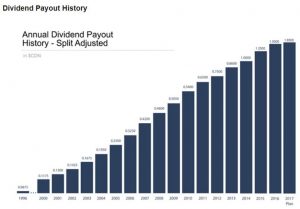 Based on the recent annual historical dividend increases, I suspect CNI will increase its annual dividend ~$0.10 to ~$1.75 (~6% increase) with the increase taking effect with the Q1 2018 dividend payment. Based on the current closing price of ~$104.50 this estimated new dividend would translate into a 1.67% dividend yield. This is comparable to that in FY2012 but is once again short of that in FY2015 and FY2016.
Based on the recent annual historical dividend increases, I suspect CNI will increase its annual dividend ~$0.10 to ~$1.75 (~6% increase) with the increase taking effect with the Q1 2018 dividend payment. Based on the current closing price of ~$104.50 this estimated new dividend would translate into a 1.67% dividend yield. This is comparable to that in FY2012 but is once again short of that in FY2015 and FY2016.
CNI reaffirmed its FY2017 adjusted diluted EPS outlook ($4.95 - $5.10). Using a current stock price of ~$104.50 and an adjusted diluted EPS of $5.03 I arrive at a price / adjusted diluted EPS ratio of ~20.78. When comparing the current price / adjusted diluted EPS ratio with that for the previous few fiscal years, this ratio appears to be somewhat elevated.
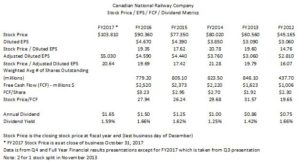
I do not profess to be in the same league as David Einhorn, Seth Klarman, and Paul Singer but my outlook on the state of most stock valuations is similar to their outlook. There are companies whose business model is suspect and whose stock is trading at unreasonable levels. This has resulted in the speculative mentality on the part of many “investors” spilling over into companies with a proven track record which have, do, and will continue to provide essential services despite disruptions in the transportation / logistics industry. If anything, modern technology will help railways become safer and more efficient.
In my opinion, I suspect CN will patiently wait for its share price to pull back before initiating its new round of share repurchases. If I am correct in that CN is likely to patiently wait for a more favorable price range, then it behooves readers to also practice patience.
Should you be unable to patiently wait on the sidelines for a better entry level, I suggest only taking a partial position in CN.
Canadian National Railway - Final Thoughts
CN’s stock price appears to be slightly elevated at ~$104.50. In my opinion, a price in the high $80s (eg. $87- $89.99) is a great "buy" range.
While some investors may think a ~15% drop in CN’s stock price is unrealistic, I am of the opinion it is not totally out of the realm of possibility if NAFTA negotiations do not go well.
I have a relatively full position in the TSX listed CN shares. These shares are held in the FFJ Portfolio and all dividends are being automatically reinvested. Despite my opinion on the price of CN shares being somewhat elevated, I have no intention of discontinuing the automatic dividend reinvestment arrangement nor of selling the shares in the hopes of repurchasing them if/when CN’s share price drops. This "hands off" approach has served me well over the years and I am not about to change.
I wish you much success on your journey to financial freedom.
Thanks for reading!
Note: I sincerely appreciate the time you took to read this post. As always, please leave any feedback and questions you may have in the “Contact Me Here” section to the right.
Disclaimer: I have no knowledge of your individual circumstances and am not providing individualized advice or recommendations. I encourage you not to make any investment decision without conducting your own research and due diligence. You should also consult your financial advisor about your specific situation.
Disclosure: I am long CN.
I wrote this article myself and it expresses my own opinions. I am not receiving compensation for it and have no business relationship with any company whose stock is mentioned in this article.

